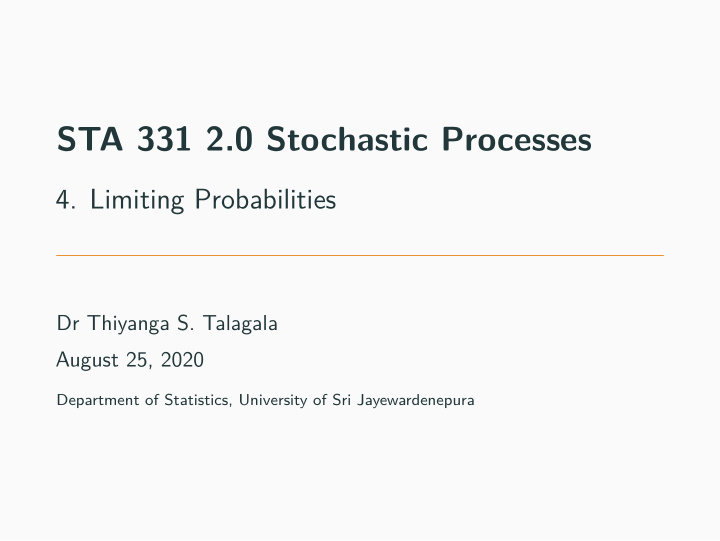



STA 331 2.0 Stochastic Processes 4. Limiting Probabilities Dr Thiyanga S. Talagala August 25, 2020 Department of Statistics, University of Sri Jayewardenepura
Markov chains: A Random Walk In-class 2
Limiting probabilities - Example Suppose that the chance of rain tomorrow depends on previous weather conditions only through whether or not it is raining today and not on past weather conditions. Suppose also that if it rains today, then it will rain tomorrow with probability 0.7; and if it does not rain today, then it will rain tomorrow with probability 0.4. If we say that the process is in state 0 when it rains and state 1 when it does not rain , i) Write down the transition probability matrix. ii) Calculate the probability that it will rain four days from today given that it is raining today. 3 iii) Compute P ( 8 ) .
Defjnition: period-d State i of a Markov chain is said to have period d if P n whenever n is not divisible by d , and d is the largest integer with this property (largest common divisor is d ). 4 ii = 0
Defjnition: aperiodic A state with period 1 is said to be aperiodic . 5
Note Periodicity is a class property. That is, if state i has period d , and states i and j communicate, then state j also has period d . 6
Defjnition: positive recurrent If state i is recurrent, then it is said to be positive recurrent if, starting in state i , the expected time until the process returns to state i is fjnite. Note: • Positive recurrence is a class property. • There exist recurrent states that are not positive recurrent. Such states are called null recurrent . 7
Theorem In a fjnite-state Markov chain all recurrent states are positive recurrent Proof: Omitted 8
Defjnition: ergodic Positive recurrent, aperiodic states are called ergodic . If all states of a Markov chain are ergodic it is called an ergodic Markov chain. 9
Fundamental Theorem for Markov Chains is independent of i . Furthermore, letting 10 For an irreducible ergodic Markov chain lim n →∞ P n ij exists and π j = lim ij , j ≥ 0 n →∞ P n then π j is the unique non-negative solution of ∞ ∑ π j = π i P ij , j ≥ 0 , i = 0 ∞ ∑ π j = 1 . j = 0
Cont. (In class) That is, the solution of system process spends in state j. 11 π j is also equal to the long run proportion of time that the
Limiting probabilities - Example Suppose that the chance of rain tomorrow depends on previous weather conditions only through whether or not it is raining today and not on past weather conditions. Suppose also that if it rains today, then it will rain tomorrow with probability 0.7; and if it does not rain today, then it will rain tomorrow with probability 0.4. If we say that the process is in state 0 when it rains and state 1 when it does not rain , i) Write down the transition probability matrix. ii) Calculate the probability that it will rain four days from today given that it is raining today. iv) Compute limiting probabilities. 12 iii) Compute P ( 8 ) .
Example A cricket coach can give two types of training, light or heavy, to his sports team before a game, depending on the results of the prior game. If the team wins the prior game, the next training is equally likely to be light or heavy. But, if the team loses the prior game, the team always needs to undergo a heavy training. The probability that team will win a game after a light training is 0.4. The probability that team will win a game after a heavy training is 0.8. Calculate the long run proportion of time that the coach will give heavy training to them. 13
Example medium in the long run. Calculate the percentage of policy holders in the high risk class 0.7 0.3 0 high 0.1 0.8 0.1 0.05 An automobile insurance company classifjes its policy holders 0.05 0.9 low high medium low transition probability matrix as follows classes is modelled as a discrete Markov process with a as low, medium or high risk. Individual transition between 14
Acknowledgement The contents in the slides are mainly based on Introduction to Probability Models by Sheldon M. Ross. 15
Recommend
More recommend